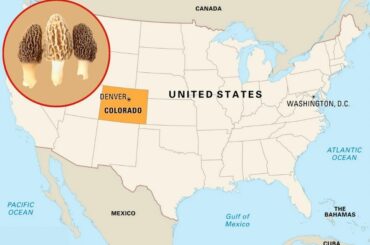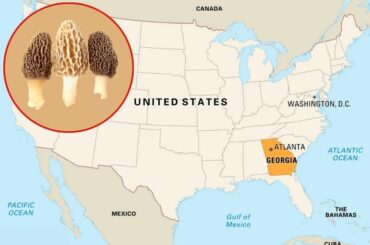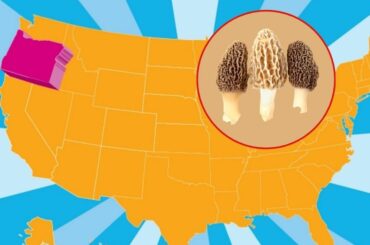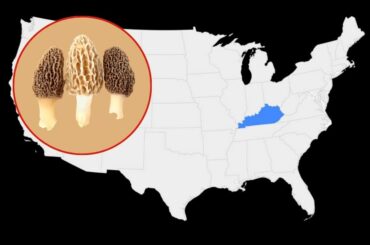Morels are among the favorite mushroom types of mushroom hunters because of their delicate structure and rich flavor. The false morel, Verpa bohemica, is often mistaken for a morel because of its similar appearance.
In this article I am going to discuss the similarities and differences of Verpa Bohemica vs Morel. If you are new to foraging, identifying true morels can be tricky. Here are a few pointers to help you distinguish between Verpa bohemica and morels.
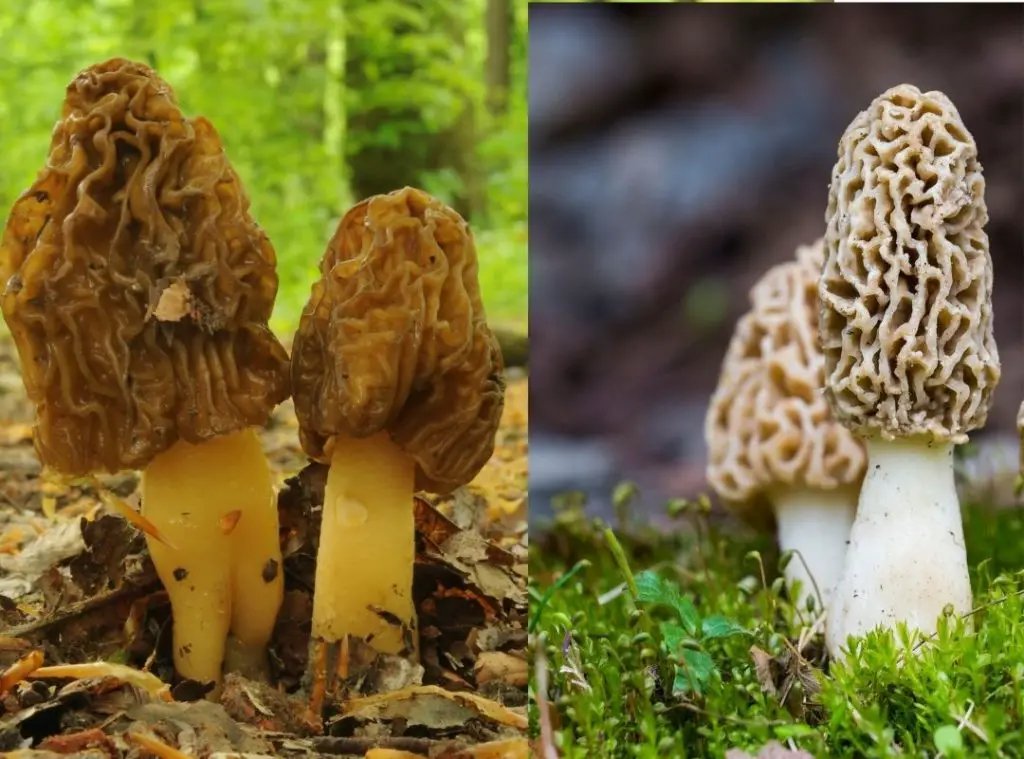
What is morel?
Contents
- 1 What is morel?
- 2 What is Verpa bohemica?
- 3 Is Verpa a morel?
- 4 Can you eat Verpa Bohemica?
- 5 Verpa bohemica vs morel – Appearance
- 6 Verpa bohemica vs morel – Where do they grow?
- 7 Verpa bohemica vs morel – When do they grow?
- 8 Verpa bohemica vs morel – Which one is edible?
- 9 Verpa bohemica vs morel – Which one is tasty?
- 10 Verpa bohemica vs morel – Toxicity
- 11 Are false morels hollow?
- 12 Verpa bohemica vs Gyromitra esculenta
- 13 Related question
- 14 Conclusion
Morels are a type of edible fungi that belongs to the Morchellaceae family. These mushrooms have cone-shaped caps with ridged or honeycomb-like structures. Morels are also hollow in structure with white to pale yellow hues. There are around 80 species of morels, but the most common ones are Morchella esculenta and Morchella elata. These mushrooms grow in spring and early summer in temperate climates.
What is Verpa bohemica?
Verpa bohemica, also known as false morel or early morel, is an edible fungus that resembles the true morel. This mushroom is also known as brain mushroom or thimble morel because of its wrinkled, brain-like appearance. Verpa bohemica is a member of the Pezizales order and Verpa Genus. This fungus is found in North America, Europe, and Asia. It grows in spring, often before the true morels appear.
Is Verpa a morel?
No, Verpa bohemica is not a morel. These two fungi may look alike, but they belong to different genera. Although both mushrooms belong to the family Morchellaceae, Morels belong to the Morchella Genus, while false morels belong to the Verpa Genus.
Can you eat Verpa Bohemica?
While false morels are known to be toxic, Verpa bohemica isn’t. Verpa bohemica is actually an edible fungus with an earthy flavor. However, it’s essential to cook Verpa bohemica before eating them. This is because Verpa bohemica contains toxins that can cause gastrointestinal issues if consumed raw. Further, you should not overeat this mushroom as it still includes toxins in small amounts even after cooking. So, if you overeat, it still can affect you.
Verpa bohemica vs morel – Appearance
Verpa bohemica and morels have a relatively similar appearance, making them hard to tell apart. Their appearances, however, differ significantly.
Cap
Verpa bohemica is attached to the stem at the center (free hanging), while the cap of morel is attached to the stem at the side. Verpa bohemica is also brain-like or wrinkled in appearance, while the cap of morel is honeycomb-like. In addition, the cap of Verpa bohemica is wider than the stem, whereas the cap of morel is about the same width as the stem.
Stem
The stem of both species is hollow, but the morel stem is thicker than the Verpa bohemica. The stem of Verpa bohemica is also longer than the stem of a morel. Usually, the length of the stem of morel is the same as the cap, while the length of the Verpa bohemica stem is longer than its cap’s length.
Color
Verpa bohemica is a pale yellow to tan in color, while morels are white to pale yellow. However, some morel species have a blackish yellow cap with a white stem.
Spore print
The spore print of Verpa bohemica is reddish-brown, while the spore print of morel is dark brown.
Spores
Spores of Verpa bohemica are significantly larger (15–18 µm ) than the spores of a morel (8-11.5 µm).
Size
Verpa bohemica can grow up to 4-12 cm in size, while morels only grow up to 10 cm. Verpa bohemica is usually taller than any morel species.
Verpa bohemica vs morel – Where do they grow?
Verpa bohemica and morels have relatively different habitats. Verpa bohemica usually grows in woodlands, while morels grow in damp areas near streams or rivers. Morels are most usually found in damp areas under deciduous trees and conifer woods. It prefers temperatures of 55–60 °F.
On the other hand, Verpa bohemica is most commonly found in coniferous forests at high altitudes. Verpa bohemica needs a cooler temperature to grow, with an optimum temperature of 50–55 °F. Verpa bohemica also has a wide range and can be found in North America, Europe, and Asia. Morels, on the other hand, are primarily found in temperate climates. They are abundant in North America but can also be found in Europe, Asia, and North Africa.
Verpa bohemica vs morel – When do they grow?
Verpa bohemica and morels have different seasons. Verpa bohemica usually grows in spring, often before the true morels appear. On the other hand, Morels mostly grow in late spring to early summer. However, some morel species can also be found in autumn. So, if you’re looking for Verpa bohemica, the best time to find them would be in spring. If you’re looking for morels, the best time to find them would be in late spring to early summer.
Verpa bohemica vs morel – Which one is edible?
Verpa bohemica is actually an edible fungus with an earthy flavor. However, it’s essential to cook them before eating them as they can cause gastrointestinal issues if consumed raw. Morels, on the other hand, are also edible fungi. They have a nutty flavor and are often used in gourmet dishes. You can eat Morels raw or cooked, but it’s generally recommended to cook them to avoid any gastrointestinal issues.
So, if you’re looking for an edible fungus, Verpa bohemica and morels are both good options. Just make sure to cook Verpa bohemica before you eat them.
Verpa bohemica vs morel – Which one is tasty?
This is a matter of personal opinion, but many people believe that morels are tastier than Verpa bohemica. Morels have a nutty flavor that goes well with many dishes, while Verpa bohemica has a more earthy flavor. So, if you’re looking for a tastier fungus, morels are the way to go.
Verpa bohemica vs morel – Toxicity
Both Verpa bohemica and morels are edible fungi. However, it’s essential to parboil and cook Verpa bohemica before eating them as they can cause gastrointestinal issues if consumed raw.
Morels can be eaten raw or cooked, but it’s generally recommended to cook them to avoid any digestive problems. Most wild mushrooms include poisons that can cause digestive problems. However, Verpa bohemica and morels are two of the most popular edible mushrooms due to their low toxicity. Nonetheless, eating a considerable amount of either variety of mushrooms, whether raw or undercooked, might cause issues.
Are false morels hollow?
This is a common misconception, but some false morels are not hollow. For example, Verpa bohemica has a hollow stem but an umbrella-shaped cap, while Gyromitra esculenta has chambered hollows in the cap with a connected stem.
False morels can be confusing, but the main difference between a true morel and a false morel is the hollow cap of true morels. True morels feature hollow centers, with the cap and stem joining as one at the base. Further, the cap of true morels is “deeply pitted” or “honeycomb-like,” but the cap of false morels is “brain-like.”
Verpa bohemica vs Gyromitra esculenta
Gyromitra esculenta is the other most common type of false morel. Both have a hollow stem, but Gyromitra esculenta has chambered hollows in the cap, while Verpa bohemica has an umbrella-shaped cap. Further, the coloration of Gyromitra esculenta can be red, yellow, or brown, while Verpa bohemica is white or tan. Gyromitra esculenta is also more toxic than Verpa bohemica, so it is generally not considered edible.
Both mushrooms can cause gastrointestinal issues if consumed raw or undercooked. Further, Gyromitra esculenta is regarded as a deadly fungus if consumed in large quantities. Therefore, experts advise avoiding Gyromitra esculenta at all costs. To sum it up, Verpa bohemica and Gyromitra esculenta are both false morels. Both have a hollow stem and brain-like cap, but only Verpa bohemica is edible. Gyromitra esculenta is more toxic and should be avoided.
Related question
Can you eat too many morels?
Although morels are edible, you can not eat too many of them. Morels are low in toxins, but eating large amounts can cause gastrointestinal issues.
Can you eat false morels raw?
No, you should not eat false morels raw as they can cause gastrointestinal issues. Both Verpa bohemica and Gyromitra esculenta are poisonous when eaten raw.
Can you drink alcohol with morels?
No. You can not drink alcohol with morels as it can increase the risk of gastrointestinal issues. Morels have low levels of hydrazine toxins which can be poisonous when consumed in large quantities, eaten raw, or eaten with alcoholic beverages.
Morels are already low in toxins, but alcohol can make the toxins more potent.
Can you get sick from morels?
Yes. You can get sick from morels if you eat them raw or undercooked. Morels have low levels of toxins, but eating large amounts can cause gastrointestinal issues. If you cook morels, they will be safe to eat. Further, if you have mushroom allergies, you can get sick from morels. Morels belong to the fungi family, which also includes mold and yeast. If you have an allergy to any type of fungi, you should avoid morels.
Conclusion
Verpa bohemica and morels are two of the most popular edible fungi. Both have low levels of toxins, but they can cause gastrointestinal issues if consumed raw or undercooked. Verpa bohemica is white or tan, while morels are a darker color. Morels have hollow caps while Verpa bohemica does not. The most distinctive feature of morels is their “honeycomb” cap, while Verpa bohemica has an umbrella-shaped cap.
So, if you want to differentiate Verpa bohemica from morels, be sure to check the cap and stem. If the stem is hollow and the cap is not, it’s a Verpa bohemica. If the stem and cap are hollow, it’s morel.
Read Next : Verpa Bohemica | Delicious Edible Mushroom |

